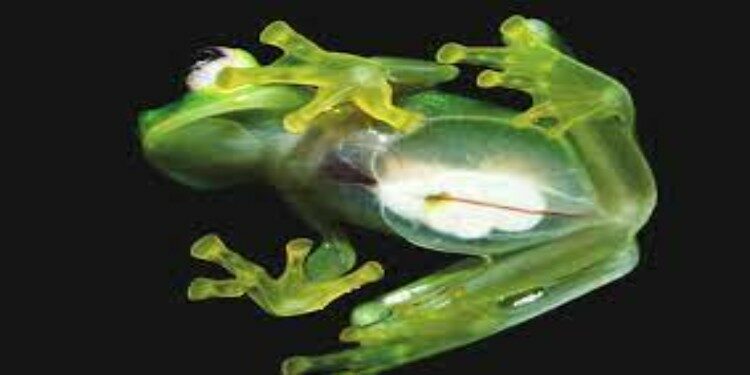In news– In a study researchers have reported that when a glass frog falls asleep, almost all of its red blood cells retreat into its liver.
About the glass frog & See through frog-
- Native to forests of Central and South America, glass frogs in the family Centrolenidae get their name from their translucent skin and muscles that blend them seamlessly into their jungle environment.
- Flip the amphibians over, where the effect is most impressive, and you’ll see their hearts, livers, and squiggly coils of intestines—no dissection needed.
- Apart from a lime green smear across its back, its skin, muscle and other tissues are see-through.
- Then there are its tiny organs, which seem to float within this clear flesh, like a pale fruit cocktail in the weirdest Jell-O salad ever to grace a tree branch.
- As handy as translucence might be for evading predators, it is rare in animals that live on land.
- Their bodies are full of substances that light can’t penetrate, many of them essential for life.
- Glass frogs seem to have evolved see-through versions of some of these anatomical features, but they also have some tricks to hide lingering colors when they are at their most vulnerable.
Key findings-
- The researchers reported that when a glass frog falls asleep, almost all of its red blood cells retreat into its liver.
- They hide in the organ and allow the frog to achieve near invisibility while it rests. In addition to revealing another remarkable adaptation in nature, the discovery could lead to clues for how to prevent deadly blood clots.
- Like people, glass frogs rely on hemoglobin, a colored protein in red blood cells that delivers oxygen around the body.
- The authors of the new paper had been spending a lot of time observing the frogs when they realized that sometimes, that red color seemed to disappear.
- To solve the mystery of the disappearing blood cells, the researchers and their colleagues wanted to take images of the frogs under anesthesia — when the blood cells were clearly visible circulating through their bodies — and asleep, when the cells were nowhere to be seen.
- To do that, they needed to find a way to peer inside the frog’s organs, which have a mirror-like exterior that helps the frog blend in.
- They suspected that the blood would retreat to various organs when not in circulation.
- The researchers wound up relying not on light but on sound to show them what was inside.
- They provoked the molecules within the sacs to release ultrasonic waves, which could be used to identify the contents.
- As soon as they compared the images of sleeping and anesthetized frogs, one big difference jumped out.
- They have found that all the signal was coming from the liver. About 89% of the frogs’ red blood cells had packed themselves into that organ.
- What was stranger, and what the researchers still don’t understand, was how the frogs could cram all these cells together without dying from blood clots.
- In most vertebrates, when blood cells bump into each other, it leads to coagulation.
- The resulting clot can make a scab to seal a wound — or, if the clot is in a blood vessel, it can plug up the circulatory system and kill the creature.
- Glass frogs, the new research suggests, can control when their blood clots. If they are wounded, they will form a scab in the usual way. But when they are asleep, with red blood cells packed like sardines in the liver, no clot forms.
- The finding implies that glass frogs could have something to teach us about how to prevent clot formation in our own bodies.
- If future research can illuminate what keeps the frogs safe, it could lead to treatments to reduce deaths from clots in humans.
- More immediately, the researchers said, the results raised other questions. If 89% of the cells that carry oxygen are holed up in the liver while the frog sleeps, how is it breathing?
- They wonder whether the frogs can shift their metabolisms to a mode that requires barely any oxygen, perhaps akin to what other frogs do when they hibernate for the winter.
Source: The Indian Express
















